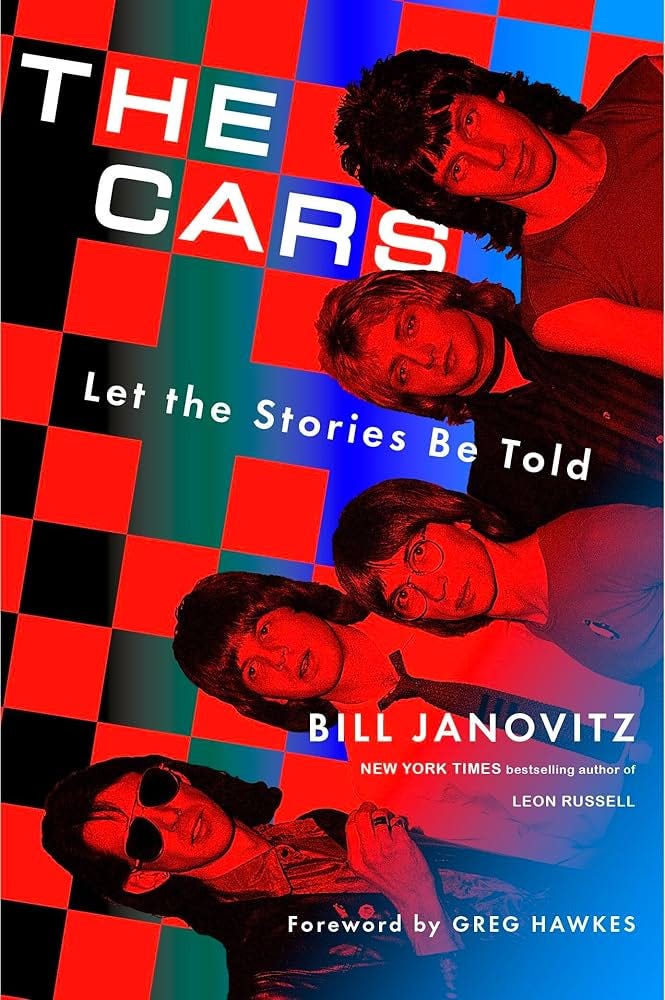The Cars: Let the Stories Be Told
The book.
So I just finished reading The Cars: Let the Stories Be Told by Bill Janovitz, and much like his book on Leon Russell, it is exhaustively researched and, indeed, stories are told. This is my second straight book about a Bostonian icon, having just finished Peter Wolf’s Waiting on the Moon: Artists, Poets, Drifters, Grifters, and Goddesses (curious note about that book is that he seems to go out of his way not to mention The J. Geils Band by name).
Anyway, where was I?
Oh yeah, if you’re reading this, you may already know that author Janovitz is the guitarist and lead singer of Buffalo Tom. If you don’t, there you go. This is worth mentioning because, like The Cars, he is from Boston and brings a musician's ear to his wordy pursuits. His musicianship comes into clear focus when he describes in detail how The Cars recorded their debut album.
As I read it, I found the level of detail annoying because I am not a musician, so much of the jargon and equipment talk was lost on me. As I moved on in the book, he tempers this considerably when describing subsequent records, so I presume the detail is to provide context for how The Cars achieved their unique sound.
What makes this a compelling read is the Roshomon-like storytelling.
In addition to many of those who were associated with the band, Janovitz had the participation of the three surviving members, keyboardist Greg Hawkes, guitarist Elliot Easton, and drummer David Robinson (bass player and singer Ben Orr died in 2000, and guitarist and singer Ric Ocasek passed in 2019). While the three share mostly the same story, there are enough instances throughout the book where one remembers a situation, one doesn’t, and one kind of does.
The book goes to great lengths to allow each of the surviving members of The Cars to tell their story, providing insight into the band’s career from three different perspectives.
Before settling into The Cars, Ocasek and Orr had a few bands. With each new incarnation and rebrand, they seemed to accumulate the members who would eventually become The Cars. Janovitz pays just enough attention to this backstory to keep you interested and reading. If for no other reason, then you know what awaits on the other side.
While Hawkes, Easton, and Robinson are present to tell their stories, the book includes supporting and, in some cases, conflicting narratives from various people in The Cars’ orbit.
By way of proxy, it’s Ocasek’s last wife, former supermodel Paulina Porizkova, who tries to provide insight into his thinking, and one of Orr’s ex-wives and a former lover, who sheds light on where Orr was mentally at different periods of The Cars’ career.
There are a couple of conspicuous omissions from the book. But I am not sure how much context Ric Ocasek’s first ex-wife and his children would add to the story of The Cars, so I get it. And for all I know, they all may have refused participation (based on reading the book, it's a high probability).
It’s funny to think about how big a band The Cars were. Even as a young kid in the Midwest, I was hyper aware of this quirky band that I somehow knew was from Boston. Within the context of the book, that regionality is vital because The Cars were as much about Boston as Boston was about The Cars. Even after their success, it would be years before any of them moved away from the Boston area.
It’s no secret that the band, much like its music, was fraught with tension. These weren’t five childhood friends who started a band (although Ocasek and Orr did have a long friendship); these are five guys who came together and discovered they made a unique sound. A sound that seemed to resonate with people. It was also a sound that the members’ solo efforts, in particular Ocasek’s, could not duplicate.
The Cars have sold around 23 million albums worldwide. Based on the band’s popularity and lasting influence, I’ll cop to the fact that I thought it would’ve been twice that. It’s still a boatload of albums over what was ostensibly a pretty short career, nine years and six original full-length studio albums.
I exclude Greatest Hits and 2011’s Move Like This because it wasn’t really the full five-piece band, and besides, even the band wasn’t entirely pleased with the album. Besides, who among us even remembers that they released an album in 2011? Wait, I forgot the audience here. You may recall it, but when was the last time you listened to it?
What Janovitz does is give each of the albums its own chapter. What makes that interesting is that you can see both how a band functions and how it deteriorates. But this isn’t a Behind the Music type of book. Well, it is, just with a shitload more context and texture.
If you’re looking for a salacious read about success, drugs, and groupies, this ain’t it. The Cars: Let the Stories Be Told is a researched, almost academic, and well-thought-out book. Of course, all of those things are mentioned (it was the 80s), but only in passing. Janovitz highlights Orr’s alcohol abuse later in his life, but it’s more observant than accusatory or scandal-ridden.
The only truly scandalous parts of The Cars' story are Ric Ocasek’s serious control issues and perhaps the fact that Benjamin Orr and Ocasek may not have been the best partners for a romantic relationship.
Bill Janovitz does a remarkable thing with The Cars: Let the Stories Be Told - he doesn’t mythologize The Cars; he humanizes them, warts and all.



